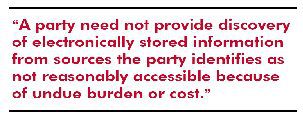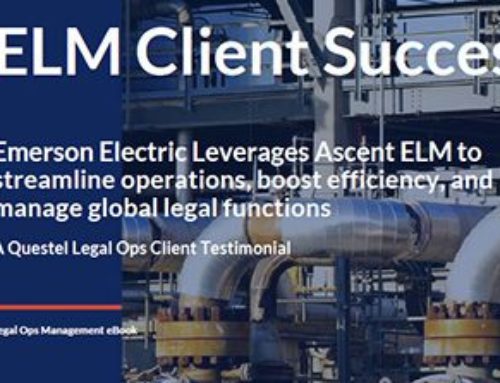Understanding Changes to FRCP Rule 26
By Adam Bowers, Esq – eDiscovery Consultant, doeLEGAL, Inc.
FRCP Rule 26 begins by requiring full disclosure of the custodians and the location of information “….that the disclosing party may use to support its claims or defenses….” The Rule also requires a party seeking monetary damages to produce itemized computations of those damages and identify the materials upon which the computations were based. The Rule demands this disclosure to be made even without that information being requested by the adverse party, which is an important point, because it lays the onus on the producing party to cooperate with the adverse party, without any court involvement. As a practical matter, it stands to reason that this information is required early on in the case for the purpose of disposing of the matter between the adverse parties. These disclosures should be made within 14 days after the 26(f) conference unless the court decides on different timing. It makes sense to require this early “showing of the cards”; if there is full disclosure, as is required, both parties will be able to evaluate the relative strength and weakness of the disputes, which will often lead to settlement, withdrawals, or summary judgment. It all goes back to Rule 1. The FRCP envisions cooperation of the parties to facilitate the “just and speedy” disposition of the case.
Moving next to the need to disclose witnesses to the adverse party, there are some timing requirements, which should be noted. The Rule requires that a party who intends to call a witness must disclose the purpose for calling the witness and identify the materials upon which the witnesses will draw their conclusions. Again, the purpose of this section is to give the adverse party the chance to research the witnesses and materials, so that the adverse party has time to prepare its case or object to the use of the witness. The common theme is “transparency and fairness” for both sides of the litigation, which should not require any court involvement.

Rule 26(b) is concerned with the actual discovery process. At the outset, 26(b) echoes the tone of Rule 1 and directs the court to facilitate discovery, with special attention being paid to proportionality. “…Parties may obtain discovery regarding any non-privileged material that is relevant to any party’s claim or defense and proportional to the needs of the case…”. The court, when deciding whether or not to order the disclosure of requested information may take into consideration the social importance of the case, amount of money at stake, the party’s ability to access the relevant information, and cost-benefit analysis of whether the information is worth the expense of discovery. The court is called upon to determine if evidence that has not yet been found is worth finding, which is an interesting position to place the judiciary.

The possible expense and burden of gathering ESI is specifically recognized by Rule 26.
“A party need not provide discovery of electronically stored information from sources the party identifies as not reasonably accessible because of undue burden or cost.”Other objections that can be raised to a discovery request, can be found in 26(b) (2) (C), which states that the court MUST limit the “frequency or extent of discovery” when the discovery is found unreasonably duplicitous or cumulative, especially when the same information can be found from less burdensome sources.
Rule 26 requires that attorneys certify, by signature, every discovery request, response, or objection. This is meant to place attorneys on notice that they are responsible for the content. The Rule goes further to explain that for any disclosure or request, an attorney or party is responsible for ensuring that the end product is consistent with the FRCP. Discovery can be a very expensive prospect, so this Rule spells out how attorneys must not use the discovery process to harass or cause undue expense to the opposing party, which is why the certification requirement was created by the 1983 Amendments. It all goes back to having a fair and balanced procedure for determining a just outcome. If a party or attorney makes an improper certification the court MUST impose sanctions, which can include an award of attorney’s fees and costs for the injured party. In 2016 there have been some hefty sanctions levied by the courts, which were primarily comprised of attorney’s fees and costs. It would be wise to remember that the courts will not take kindly to any impropriety.

The Amended Rule 26 has shortened the time that a party is permitted to make a Rule 34 discovery request from 30 to 21 days after the summons and complaint are served. This can be misleading because discovery requests are not considered “served” until the 26(f) conference is held. The purpose of allowing the delivery of the requests, but not the service of the same, is to encourage open discussion and debate at the Meet and Confer Conference (MCC). As a strategic matter, one may choose not to “tip their hat” prior to the MCC, but that would be a case-sensitive decision. The MCC is meant to serve the purpose of the speedy disposition of civil cases. Rule 26 does not delineate between methods of discovery nor give any hierarchy of different methods. It has often been said that the party, from whom discovery is requested, is in the best position to determine how the materials should be researched and produced.
Rule 26 contains several requirements and duties, which must be followed. The difference between an attorney who knows the rules and an attorney who understands how to use them to his/her advantage can be clearly identified by how they decide to use the discovery process. Rule 26 is one of the Rules that can separate a good attorney from a great attorney. Lawyers who have taken the steps to learn about how technology has changed the legal landscape are at a huge advantage. Rule 26 has transformed over the years to be inclusive of technology.
Adam Bowers is an attorney himself, graduating from Albany Law School and a seasoned eDiscovery expert. With law firm experience and knowledge of legal technology solutions, his unique perspective on combining both law firm strengths with advanced legal technology has helped numerous law firms add greater value to their global client base.[/vc_column_text][/vc_column][/vc_row]





